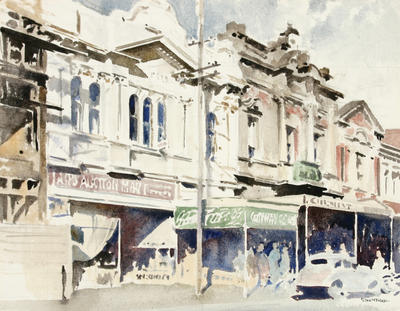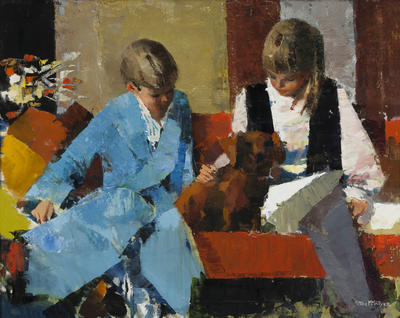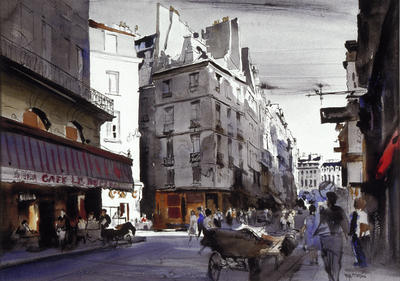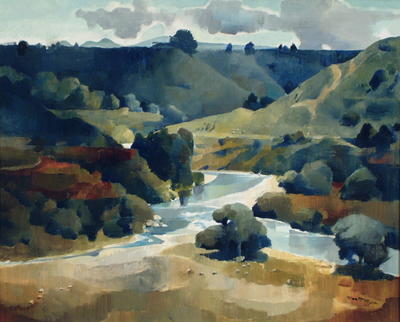Peter McIntyre
Biography
Peter McIntyre was born in Dunedin on 4 July 1910, the son of Peter McIntyre, an emigrant from Scotland, and his wife, Isabella Edith Cubitt. His father was a co-founder of the Caxton Printing Company and was well known for his lithographic work. He also worked as a cartoonist for the Otago Daily News. He was educated at Otago Boys' High School and, encouraged by his father, received instruction in art from Alfred O’Keeffe, a local artist, executing several works for family and friends. After completing his schooling, he then went onto the University of Otago, intending to study journalism. However, by 1931, McIntyre had decided to pursue art studies and abandoned his courses in New Zealand.
McIntyre went to London where he attended the Slade School of Fine Art, studying for a Bachelor of Fine Arts. He enjoyed life in London, mixing with fellow students and attending exhibitions. Despite limited income, he often travelled to mainland Europe and painted scenes in France, Germany, Italy and Spain. In 1934, his final year of studies at Slade, he won prizes in composition and figure drawing.
Following his graduation, McIntyre remained in England, working as a free-lance commercial artist. His work was varied; he did artwork for theatre productions, murals for restaurants, and serials for woman's magazines. He also did his own contemporary work in modern styles such as French cubism and English avant-garde. In 1937, he married an Englishwoman, Lillian née Welbourn, herself a painter in addition to being a model.
On the outbreak of the Second World War, McIntyre attempted to enlist in the British Army but was declined. He soon found out that New Zealand expatriates were able to join a section of the 2nd New Zealand Expeditionary Force (2NZEF) that was being raised in London. He promptly enlisted, an act that he did not consider to be particularly patriotic but motivated more by self-defence against a fascist threat. The London section of the 2NZEF became the 34th Anti-tank Battery which received its training at Aldershot. In April 1940, the unit left England for Egypt, where it was initially based at Maadi Camp, on the outskirts of Cairo, and attached to the 2nd New Zealand Division.
While in Egypt, McIntyre's artistic skills were soon recognised. He provided drawings for Parade, a military magazine and was invited to prepare artwork to form the basis of a security poster. The artwork was later used for a postcard and McIntyre also worked on the divisional Christmas card. On his own time, he also executed landscapes and portraits of fellow soldiers of the 2NZEF.
His skills soon saw him transferred to the draughting office at the headquarters of the 2nd New Zealand Division, preparing maps and drawings of Italian defensive positions based on aerial photographs. His workspace was surrounded by some of his own artwork which soon attracted the attention of the division's commander, Major General Bernard Freyberg. For some time, the New Zealand Government had been considering appointing an official war artist to record the exploits of its men at war but was yet to make a commitment. In January 1941, Freyberg, tiring of the lengthy appointment process, selected McIntyre as the official New Zealand war artist, promoting him to lieutenant at the same time.
In his new role, it was proposed that McIntyre would execute portraits of decorated soldiers, battle scenes, and a series on the life of a New Zealand soldier, both in the frontlines and in the rear areas. McIntyre's first orders from Freyberg were to paint portraits of the brigadiers of the 2nd New Zealand Division, a task of which he soon tired. However, he soon found that Freyberg allowed him plenty of leeway in what was to be produced.
When the 2nd New Zealand Division was sent to Greece, as one of a number of Allied units dispatched to support the country in early March 1941 in anticipation of an invasion by Germany,McIn tyre was ordered to remain in Egypt. Following the disastrous Allied campaign in Greece, the division was evacuated to Crete. He petitioned Freyberg for permission to be sent there, was successful, and arrived in Crete on 14 May. His first task was to paint a portrait of the King of Greece, who had been evacuated to the island. McIntyre was present during the airborne invasion of 20 May 1941 and it was at this time that he began to establish his methods for capturing events as they unfolded before him. He would work relatively close to the frontlines, executing sketches from which he would later work up paintings. In doing so, he moved away from his avant-garde influenced style and developed a romantic realism in his work.
From the fighting in Crete, McIntyre produced a number of notable works; landings of Fallschirmjäger (paratroopers), bombing of divisional field hospitals, and crashed German gliders. The latter images features German war dead; he did not depict New Zealand dead although he would show wounded. On returning to Egypt after the division had been evacuated from Crete at the end of May, several of McIntyre's works were published in Parade magazine. He was not able to bring with him all his paintings; some of the larger watercolours had to be abandoned in Crete.
In Egypt, McIntyre's initial focus was converting the many sketches he had made on Crete into proper paintings.[20] Impressed by the output, Freyberg promoted him to captain. The first exhibition of his work was held in Cairo in July 1941 and some of his work was also used to illustrate an article in the Illustrated London News later in the year. The 2nd New Zealand Division was in the process of being rebuilt following the campaigns in Greece and Crete and McIntyre captured aspects of this process; he depicted many scenes of camp life and the daily activities. When authorities announced the award of the Victoria Cross to Lieutenant Charles Upham of the 20th Battalion, McIntyre was instructed to undertake a portrait of him. When the division moved to the frontlines to participate in Operation Crusader, McIntyre went with it, sketching battle scenes and depictions of New Zealanders on the move. He was among those that was able to get into Tobruk and once there made several sketches and paintings of the besieged port.
Another exhibition of his work was held in Cairo in April 1942, which was well received. McIntyre also spent time with the Long Range Desert Group, which had many New Zealanders serving with it. He would produce several works from this experience.
In 1943, selected pieces of McIntyre's art work was used by the New Zealand publishing company A.H. Reed Limited, to illustrate Passage to Tobruk, a memoir by Francis Jackson that was published under Reed's Raupo imprint.
At the end of the war, he had been promoted to major.
Returning to Dunedin in February 1946, McIntyre set up a studio on the city's Princes Street. He worked fulltime on commissioned portraits and landscapes. He had planned on establishing a school for the arts beginning with the development of a community of likeminded artists. However, this proved to be a challenge as he found the local art scene to be amateurish.
In early 1949, his marriage to Lillian McIntyre ended in divorce and he promptly remarried. He and his new wife, Patricia née Miles and moved to Wellington, where he based himself in Mount Victoria. He was a professional portrait and landscape painter, critical of modernism and modern art. He was successful in art competitions,[1] placing third in the 1957 Kelliher Art Award with a landscape of the Rangitikei River and winning outright two years later with a scene of Dunedin's Octagon. He was third again in 1960, 1961 and 1963.
In 1962 McIntyre was approached by Ray Richards, of A.H. Reed Limited, with a suggestion of writing a book on his career. This proved to be The Painted Years, the first of several books authored and illustrated by McIntyre. It was a success, and led to his commissioning by Reed to produce a volume with landscapes of New Zealand. This was Peter McIntyre's New Zealand, published in 1964. The first print run of 5,000 sold out within days and the book would remained in print for 20 years. His next book was Peter McIntyre's Pacific, published in 1966, was also a success and ended up being distributed into the United States. A Californian company, Lane Publishing Company, partnered with Reed and McIntyre to produce Peter McIntyre's West, containing scenes from the western states. This was published in 1970, selling over 27,000 copies and boosting McIntyre's profile in the United States.
In the 1970 New Year Honours, McIntyre was appointed an Officer of the Order of the British Empire for services to the arts. His work remained of public interest, with high prices paid throughout the 1970s and 1980s for his paintings. He also continued to produce books; a particularly personal project for McIntyre was Kakahi. Named for the small town in the King Country where he owned a holiday home, the book highlighted themes of conservation and rural landscapes. McIntyre's Country was published in 1979 and the last of his books was Peter McIntyre: War Artist. This was published in 1981 and returned his war art to the public eye.
After journalists made enquiries, it was found that the works executed by the official war artists during the Second World War, and which were the property of the New Zealand Government, had been widely dispersed throughout the country. Many were displayed at Returned Services Associations, regional museums, and government departments without thought given to their care. The poor condition of many works resulted in public criticism being directed towards the nominal custodian of the works, the Department of Internal Affairs. After initially claiming it lacked hanging space for them, it set about centralising the war artist's work to the National Archives. It transpired that of the 160 Mcintyre works in the collection, 40 needed some restoration work.
He died in Wellington on 11 September 1995, survived by his wife and two children. Earlier in the year, Wellington City Gallery held an exhibition of his war art; over 22,000 people had viewed his work by the time of his death. His work continues to be sought after; an auction held in November 2015 of paintings of farming scenes fetched prices well above of what was expected.
https://en.wikipedia.org/wiki/Peter_McIntyre_(artist)
McIntyre went to London where he attended the Slade School of Fine Art, studying for a Bachelor of Fine Arts. He enjoyed life in London, mixing with fellow students and attending exhibitions. Despite limited income, he often travelled to mainland Europe and painted scenes in France, Germany, Italy and Spain. In 1934, his final year of studies at Slade, he won prizes in composition and figure drawing.
Following his graduation, McIntyre remained in England, working as a free-lance commercial artist. His work was varied; he did artwork for theatre productions, murals for restaurants, and serials for woman's magazines. He also did his own contemporary work in modern styles such as French cubism and English avant-garde. In 1937, he married an Englishwoman, Lillian née Welbourn, herself a painter in addition to being a model.
On the outbreak of the Second World War, McIntyre attempted to enlist in the British Army but was declined. He soon found out that New Zealand expatriates were able to join a section of the 2nd New Zealand Expeditionary Force (2NZEF) that was being raised in London. He promptly enlisted, an act that he did not consider to be particularly patriotic but motivated more by self-defence against a fascist threat. The London section of the 2NZEF became the 34th Anti-tank Battery which received its training at Aldershot. In April 1940, the unit left England for Egypt, where it was initially based at Maadi Camp, on the outskirts of Cairo, and attached to the 2nd New Zealand Division.
While in Egypt, McIntyre's artistic skills were soon recognised. He provided drawings for Parade, a military magazine and was invited to prepare artwork to form the basis of a security poster. The artwork was later used for a postcard and McIntyre also worked on the divisional Christmas card. On his own time, he also executed landscapes and portraits of fellow soldiers of the 2NZEF.
His skills soon saw him transferred to the draughting office at the headquarters of the 2nd New Zealand Division, preparing maps and drawings of Italian defensive positions based on aerial photographs. His workspace was surrounded by some of his own artwork which soon attracted the attention of the division's commander, Major General Bernard Freyberg. For some time, the New Zealand Government had been considering appointing an official war artist to record the exploits of its men at war but was yet to make a commitment. In January 1941, Freyberg, tiring of the lengthy appointment process, selected McIntyre as the official New Zealand war artist, promoting him to lieutenant at the same time.
In his new role, it was proposed that McIntyre would execute portraits of decorated soldiers, battle scenes, and a series on the life of a New Zealand soldier, both in the frontlines and in the rear areas. McIntyre's first orders from Freyberg were to paint portraits of the brigadiers of the 2nd New Zealand Division, a task of which he soon tired. However, he soon found that Freyberg allowed him plenty of leeway in what was to be produced.
When the 2nd New Zealand Division was sent to Greece, as one of a number of Allied units dispatched to support the country in early March 1941 in anticipation of an invasion by Germany,McIn tyre was ordered to remain in Egypt. Following the disastrous Allied campaign in Greece, the division was evacuated to Crete. He petitioned Freyberg for permission to be sent there, was successful, and arrived in Crete on 14 May. His first task was to paint a portrait of the King of Greece, who had been evacuated to the island. McIntyre was present during the airborne invasion of 20 May 1941 and it was at this time that he began to establish his methods for capturing events as they unfolded before him. He would work relatively close to the frontlines, executing sketches from which he would later work up paintings. In doing so, he moved away from his avant-garde influenced style and developed a romantic realism in his work.
From the fighting in Crete, McIntyre produced a number of notable works; landings of Fallschirmjäger (paratroopers), bombing of divisional field hospitals, and crashed German gliders. The latter images features German war dead; he did not depict New Zealand dead although he would show wounded. On returning to Egypt after the division had been evacuated from Crete at the end of May, several of McIntyre's works were published in Parade magazine. He was not able to bring with him all his paintings; some of the larger watercolours had to be abandoned in Crete.
In Egypt, McIntyre's initial focus was converting the many sketches he had made on Crete into proper paintings.[20] Impressed by the output, Freyberg promoted him to captain. The first exhibition of his work was held in Cairo in July 1941 and some of his work was also used to illustrate an article in the Illustrated London News later in the year. The 2nd New Zealand Division was in the process of being rebuilt following the campaigns in Greece and Crete and McIntyre captured aspects of this process; he depicted many scenes of camp life and the daily activities. When authorities announced the award of the Victoria Cross to Lieutenant Charles Upham of the 20th Battalion, McIntyre was instructed to undertake a portrait of him. When the division moved to the frontlines to participate in Operation Crusader, McIntyre went with it, sketching battle scenes and depictions of New Zealanders on the move. He was among those that was able to get into Tobruk and once there made several sketches and paintings of the besieged port.
Another exhibition of his work was held in Cairo in April 1942, which was well received. McIntyre also spent time with the Long Range Desert Group, which had many New Zealanders serving with it. He would produce several works from this experience.
In 1943, selected pieces of McIntyre's art work was used by the New Zealand publishing company A.H. Reed Limited, to illustrate Passage to Tobruk, a memoir by Francis Jackson that was published under Reed's Raupo imprint.
At the end of the war, he had been promoted to major.
Returning to Dunedin in February 1946, McIntyre set up a studio on the city's Princes Street. He worked fulltime on commissioned portraits and landscapes. He had planned on establishing a school for the arts beginning with the development of a community of likeminded artists. However, this proved to be a challenge as he found the local art scene to be amateurish.
In early 1949, his marriage to Lillian McIntyre ended in divorce and he promptly remarried. He and his new wife, Patricia née Miles and moved to Wellington, where he based himself in Mount Victoria. He was a professional portrait and landscape painter, critical of modernism and modern art. He was successful in art competitions,[1] placing third in the 1957 Kelliher Art Award with a landscape of the Rangitikei River and winning outright two years later with a scene of Dunedin's Octagon. He was third again in 1960, 1961 and 1963.
In 1962 McIntyre was approached by Ray Richards, of A.H. Reed Limited, with a suggestion of writing a book on his career. This proved to be The Painted Years, the first of several books authored and illustrated by McIntyre. It was a success, and led to his commissioning by Reed to produce a volume with landscapes of New Zealand. This was Peter McIntyre's New Zealand, published in 1964. The first print run of 5,000 sold out within days and the book would remained in print for 20 years. His next book was Peter McIntyre's Pacific, published in 1966, was also a success and ended up being distributed into the United States. A Californian company, Lane Publishing Company, partnered with Reed and McIntyre to produce Peter McIntyre's West, containing scenes from the western states. This was published in 1970, selling over 27,000 copies and boosting McIntyre's profile in the United States.
In the 1970 New Year Honours, McIntyre was appointed an Officer of the Order of the British Empire for services to the arts. His work remained of public interest, with high prices paid throughout the 1970s and 1980s for his paintings. He also continued to produce books; a particularly personal project for McIntyre was Kakahi. Named for the small town in the King Country where he owned a holiday home, the book highlighted themes of conservation and rural landscapes. McIntyre's Country was published in 1979 and the last of his books was Peter McIntyre: War Artist. This was published in 1981 and returned his war art to the public eye.
After journalists made enquiries, it was found that the works executed by the official war artists during the Second World War, and which were the property of the New Zealand Government, had been widely dispersed throughout the country. Many were displayed at Returned Services Associations, regional museums, and government departments without thought given to their care. The poor condition of many works resulted in public criticism being directed towards the nominal custodian of the works, the Department of Internal Affairs. After initially claiming it lacked hanging space for them, it set about centralising the war artist's work to the National Archives. It transpired that of the 160 Mcintyre works in the collection, 40 needed some restoration work.
He died in Wellington on 11 September 1995, survived by his wife and two children. Earlier in the year, Wellington City Gallery held an exhibition of his war art; over 22,000 people had viewed his work by the time of his death. His work continues to be sought after; an auction held in November 2015 of paintings of farming scenes fetched prices well above of what was expected.
https://en.wikipedia.org/wiki/Peter_McIntyre_(artist)
b.1910, d.1995
Place Of Birth
Place Of Death
Nationality
Related Information









